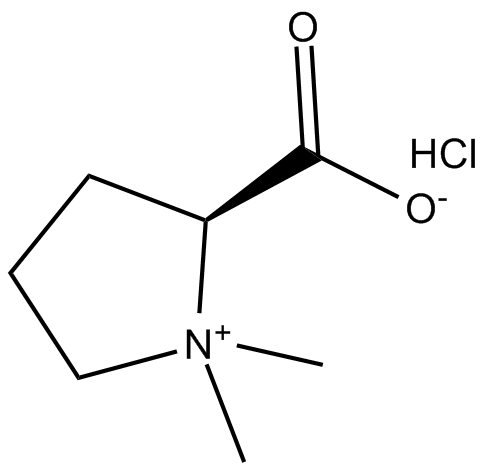Stachydrine (hydrochloride) |
| Catalog No.GC13840 |
La estaquidrina (clorhidrato) es el componente activo principal de Herba Leonuri, que es una terapia potencial para las enfermedades cardiovasculares.
Products are for research use only. Not for human use. We do not sell to patients.

Cas No.: 4136-37-2
Sample solution is provided at 25 µL, 10mM.
Stachydrine is an anti-metastatic agent.
Stachydrine, a pyrrolidine betaine, was first isolated from seed husk and the pulp of the fruit of C. Leonurus, and many other Asian plants and fruits.
In vitro: The aim of a previous study was to investigate the effects of stachydrine (STA) on norepinephrine (NE) induced hypertrophy and the changes of calcium transients in neonatal rat cardiomyocytes. Results showed that NE treatment could increase protein synthesis, cell surface area, the expression level of β-MHC and β/α-MHC ratio and these effects were attenuated by STA treatment. In addition, NE-induced hypertrophy was associated with accelerated decay of Ca2+-transient, increased phospholamban expression, increased Ca2+-transient amplitude, hyper-phosphorylation, increased intracellular cAMP level, as well as PKA overactivation. All of these effects could be inhibited by STA treatment significantly [1].
In vivo: Previous study evaluated the effect of stachydrine on the expression of caspase-9 and 12 in rats with unilateral ureteral obstruction. Results showed that degree of renal interstitial fibrosis, serum creatinine, blood urea nitrogen, the renal tubular interstitial damage index, and expression of caspase-9 and 12 in the stachydrine-treatment groups were significantly decreased [2].
Clinical trial: So far, no clinical study has been conducted.
References:
[1] Zhang, C. ,Shan, X.-L.,Liao, Y.-L., et al. Effects of stachydrine on norepinephrine-induced neonatal rat cardiac myocytes hypertrophy and intracellular calcium transients. BMC Complement. Altern. Med. 14, 474 (2014).
[2] Zhang C, Lu Y, Zhou YJ, Tong QQ, Qu C, Kang TJ. The effect of stachydrine on the expression of caspase-12 in rats with unilateral ureteral obstruction. J Urol. 2014 Nov;192(5):1549-54.
Average Rating: 5 (Based on Reviews and 29 reference(s) in Google Scholar.)
GLPBIO products are for RESEARCH USE ONLY. Please make sure your review or question is research based.
Required fields are marked with *




















